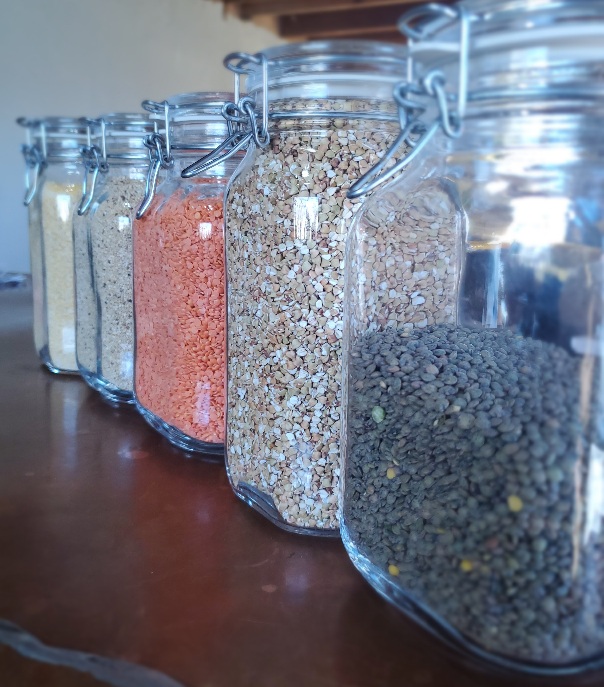I avoid excess packaging as a rule. For years, I used metal canisters from a thrift store to fill with grains, beans, etc. in the bulk aisle at the local food coop. It’s quite satisfying to pull the handle down and listen to the grains jumping around as they fill up the container.
During covid we couldn’t bring our own containers in and the bulk bins disappeared for quite a spell. Everything from the bulk aisle was pre-bagged in plastic. Frustrating for sure, but a great relief when the bins eventually returned.
 That collection of metal canisters has been with me for almost 15 years at this point. Each one ran me exactly 99 cents. The tattered price stickers were still stuck on the bottom. These repurposed cookie tins put in some serious years of service.
That collection of metal canisters has been with me for almost 15 years at this point. Each one ran me exactly 99 cents. The tattered price stickers were still stuck on the bottom. These repurposed cookie tins put in some serious years of service.
Simple, whole foods are the staple of my diet. From these ingredients, I make our meals from scratch most days. This approach lends itself to minimal packaging in general.
Plastic packaging isn’t just horrible for the planet and all the life it contains. It seriously damages our endocrine system (an overseer of such functions as nutrient usage, energy production, stress response, immune regulation, reproduction…). Avoiding exposure to plastics and avoiding plastic food/ liquid storage in particular is of enormous significance for addressing endocrine imbalances.
I also really appreciate the opportunity to get local ingredients as much as possible, which also often nicely ties in with an option of being able to use your own bags or skip them altogether. It’s a practice that supports the local economy AND ecology… not to mention it fortifies your inner ecosystem. Local foods that are grown without pesticides are a true gift to your microbiome.
So recently, I came to the realization that I was ready for an upgrade in the non-plastic dry goods storage department. My husband noted that it would be easier if we could see the contents of the (now practically vintage) tins for meal planning, etc. I may know what’s in the tins/ spice jars, etc. But I’m totally embracing the new habit of sharing this information more and more readily and clearly so that I can free up my brain space for all sorts of better, more interesting topics.
I found these beautiful glass jars and got them all ready with a friend’s help (pro tip ~ if you’re going to disassemble the metal clasps when you wash the jars and lids, make sure you keep one intact as a model! It turns out the direction of each part actually matters).
I’ve been delighting in transferring the lentils, the beans, the quinoa, the polenta, the oats, the rice…
And in the process, I realized quickly how profound it is to be able to see what we’re dealing with ~ on so many levels.
In my work as a holistic health coach I focus on supporting lifestyle changes through building new habits: simple habits, but ones that have a powerful effect on our health.
The truth is that despite our best intentions to make healthy shifts, we’re often derailed by our own unconscious habits… well-worn, automatic behaviors that seem so deeply ingrained that we often mistakenly think of them as “just who we are,” some sort of essential part of ourselves.
Who we are is an evolving story. And if we’re truly learning, we are fundamentally changed by each new lesson, each new piece of the puzzle that we take in rewires us in mind and body. Change is inseparable from life itself. Resistance to change is the source of a whole lot of unnecessary strain and struggle. I guess that’s a topic for another post.
But I’ve come to learn that building new, supportive habits requires seeing yourself in a new light. And that building new habits goes hand in hand with healing dysfunctional ones. And it’s really impossible to heal those without truly seeing them for what they are ~ and seeing them with compassion.
The next time your frustrating is rising, you’re running into a chronic challenge or pattern, try asking yourself what it is that you need to see, and see with compassion. Adopt an attitude of willingness to see what needs to be seen in order to start taking steps to heal the pattern.
It’s so common to not want to face the unpleasant or uncomfortable aspects of ourselves. Avoiding that discomfort drives a staggering percentage of our automatic behaviors.
I’m always shocked how liberating it is to bring my light into those dark and dusty recesses that I’ve avoided or neglected ~ within myself, or even in some corner of my house. Having the courage to actually see things for what they are ~ and to clear away the heavy stories we carry around about all those dark corners, to bring compassion to our vision, is unbelievably empowering. In fact, it’s healing.

Clear vision is a superpower.
Shining some light onto the areas we need help with is where it all starts.
I’ve let go of the old canisters now.
At 99 cents each, after 15 years of containing all those grains and beans, they more than held up their end of the deal.
And knowing that we can now all appreciate the beauty of our lentils, rice, quinoa, etc. ~ and clearly see what we’re working with ~ is truly priceless.

